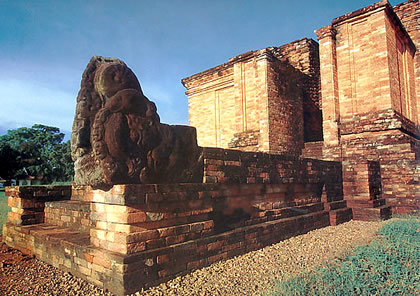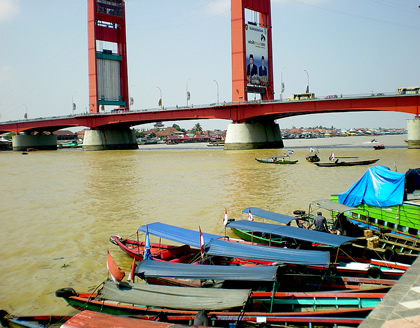 |
| Borobudur |
Borobudur, the largest Buddhist monument in the world, is located in central Java. Surrounded by fertile rice fields and coconut plantations, the Buddhist stupa is located on a small hill above Kedu Plain.
It was built in 760 to resemble a mountain and was completed in 830. Borobudur is associated with two Buddhist powers—the Sanjaya rulers and the Sailendra dynasty—which displaced the Sanjayas in 780, though the latter regained power in 850. The monument is made from more than a million blocks of stone, each weighing about 100 kilograms. These stones were arduously carried up a hill from a nearby riverbed.
These blocks of stone were then cut and carved by skilled Javanese craftsmen to form rich artistic depictions of stories familiar to Buddhist pilgrims. These bas-relief panels relate ancient fables, fairytales, and the life of Gautama Buddha. The panel reliefs were based on earlier Tantric designs.
 |
The complex meaning of Borobudur is found in deciphering the architecture and the reliefs carved into stone. Borobudur yields multiple layers of meaning rather than one single concept, although the skilful builders managed to combine different elements into a harmonious whole.
The impressive structure was built in the Mahayana tradition of Buddhism, which focuses on the personal, solitary, ascetic journey to achieve Nirvana. Ancient pilgrims made their way up the stupa to attain spiritual merit. Borobudur has a simple structure, consisting of a series of concentric terraces.
An aerial view reveals that the Borobudur temple is actually a large mandala, often employed to initiate Buddhists into higher levels of consciousness and spiritual power. As Buddhist pilgrims progress upwards, they are moving through increasingly higher planes of consciousness, with the aim of ultimately attaining Nirvana. In order to achieve enlightenment, pilgrims had to make 10 rounds in the monument.
 |
| Borobudur and the surrounding environtment |
At the summit, there is a large stupa surrounded by 72 smaller stupas. Built to visually stimulate, Borobudur enables pilgrims to forget the outside world, as the visitor walks through enclosed galleries. On the round terraces the pilgrim witnesses a view of surrounding green fields, feeling a sense of elation symbolizing enlightenment, the ultimate aim of such a pilgrimage.
The awesome structure of Borobudur provides Buddhist pilgrims with physical space to achieve spiritual enlightenment as they pass through 10 stages of development. It was a place to achieve the practical end of becoming a bodhisattva, an exalted being who is actively seeking enlightenment.
 |
| Aerial view of Borobudur |


